Planetarian or
EnvironmentalArtwork
Part 3 -
Copyright © 2011, 2012, 2016 by Craig Carlton Dremann, both text and images.
PLANETARIAN ARTWORK
is a new form of artistic expression,
where the image tells a story about local natural ecosystems or
the planetary environment, and the title of the image explains
that story in depth, as shown below. These stories are to express
the concept of "Whole Planet Awareness" or in
the French language, "Conscience Planète Entière."
Title: "FIRST TIME IN OVER 200 YEARS, someone is replanting the local native plants on this site, after the site got overwhelmed by European annual and perennial weed grasses and Italian thistles, and this site is located above the parking lot at the Arastradero Preserve, Palo Alto, California in summer 2012 you see a person cutting the weed grasses and using their stalks as mulch to be used to smother the weed grass seedlings as they germinate in winter."
Acrylics on canvas, 6" x 12" Painting #41 in catalogue. Painting #41 in catalogue. Copyright image and text © 2012 by Craig Carlton Dremann, all right reserved.
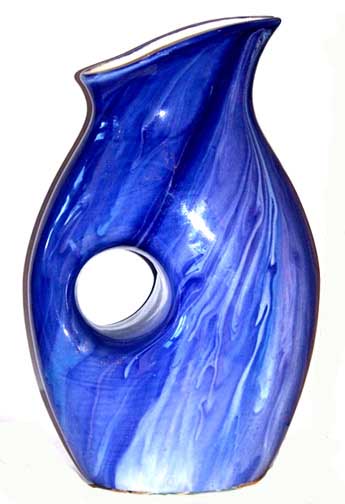
Title: "WHEN RIVERS FLOW AGAIN in Arabia,
a vase to dip into that lovely, life-giving water that has been
missed for 5,500 years."
Cermaic vase, 5" x 8" artifact #42 in catalogue. Copyright
image and text © 2012 by Craig Carlton Dremann, all right
reserved.
Title: "FIRST TIME IN OVER 200 YEARS, someone is replanting the local native grasses and wildflowers on a hillside in Palo Alto, but first everything that looks green in this painting has to be managed--because all the green in this field are European weed grass and European thistle seedlings germinating--and it is also necessary to manage the weed seedlings coming up in the gray areas--last year's Italian thistle dried stalks--and the weed seedlings are eliminated using straw mulch that was laid down earlier in the summer, and native plant seedlings being planted while the rainbow was overhead the afternoon of December 21, 2012."
Acrylics on canvas, 6" x 12" Painting
#43 in catalogue. Copyright image and text © 2012 by Craig
Carlton Dremann, all right reserved.
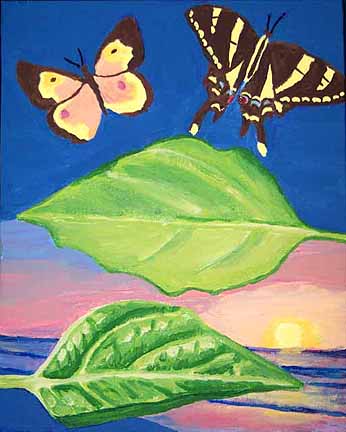
Title: "The STORY told by the PEPPER LEAVES in Haiti, the Scotch Bonnet pepper plant known asCapsicum chinense, developed by the ancestors of the Tainos Native Americans, along with corn, beans, and squashes, and these crops are the last evidence that Haiti was home to those exterminated people for at least 1,500 years, and the pepper leaves are talking to us today, and telling about the past and also forecasting the future of the people in Haiti,
and the pepper leaves are telling a story that for last 200 years, the people forgot to fertilize the farm fields, so that each time a crop was harvested, a little bit of calcium was removed, so that after 200 years the calcium level is now close to zero, and what happens to farmland when it runs out of calcium, is that it stops growing and producing crops,
so that currently there is only enough calcium left for another 10-20 years worth of crops, and after that time, without fertilizers added the island will have to be abandoned because crops will not be able to grow and that is why the painting shows a sunset off the coast of Haiti, that without adding limestone to the fields, crop production will end very soon,
However, there is an easy fix to this lack of calcium that the pepper leaves are telling us about, that there are deposits of limestone in Haiti and when the pepper leaves are flat, then there is adequate calcium to grow crops, but if the leaves wrinkle, then limestone must be added until the leaves flatten out again,
and the two Haitian butterflies in the painting, the Scarce Haitian Swallowtail (Papilio aristor), a Threatened Species whose larvae feed on citrus and the Southern Dogface (Zerene cesonia) whose caterpillar food plants are plants in the bean family,
these butterflies represent Papa Loko, who is the Haitian spirit of vegetation and gives healing or medicinal properties to leaves, and the pepper leaves will be able to diagnose and help cure the calcium poverty in the farmlands, to help the Haitian people continue to grow their crops."
Acrylics on canvas, 8" x 10" Painting
#44 in catalogue. Copyright image and text © 2012 by Craig
Carlton Dremann, all right reserved.
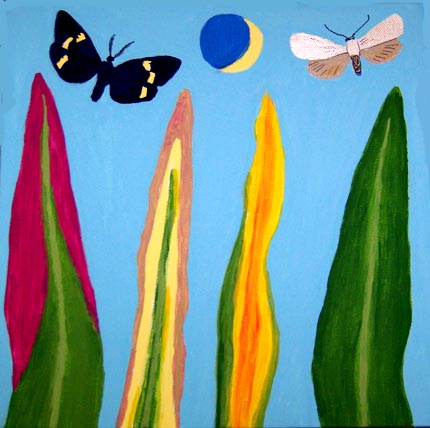
Title: "THE CORN LEAVES' GIFT TO THE FARMERS of Haiti and the World, by reading the colors of the leaves, farmers will be able to know when key soil nutrients are low, and by adding the proper fertilizers, the corn indicates adequate supplies by turning green, and this painting is taken from photos from Howard B. Sprague's book Hunger Signs in Crops, from the third edition, pages 48-49, and the two newly discovered Haitian moths are the corn spirits flying over the crop with the crescent moon, are watching over the corn crop on the island, and they are the Eremonidia mirifica and the Caribojosia youngi, and they are hoping the farmers will notice that the red in the leaves or corn stem means a phosphorus deficiency exists, and the tan edge of the leaves with the yellow means potassium is lacking, and the yellow in the older leaves, means that nitrogen is needed immediately."
Acrylics and pen on canvas, 10" x 10"
Painting #45 in catalogue. Copyright image and text © 2013
by Craig Carlton Dremann, all right reserved.
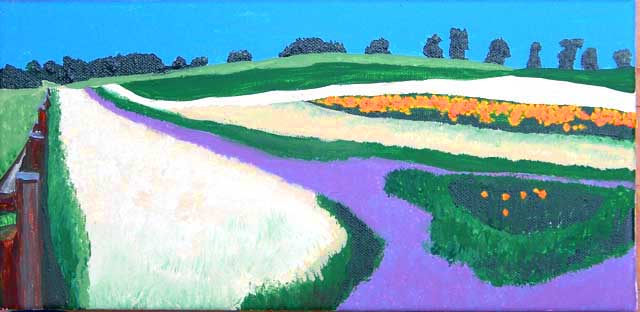
Title: "WILDFLOWERS BLOOMING after a 200-year absence from a Palo Alto, California hillside, where one thousand California poppy seedlings were planted, and 2,000 and 2,500 blooms produce the protein-rich pollen needed by the native bumblebees--and the people may look at this planting as a nice visual addition to the preserve, but to each bumblebee it is a life or death matter--and by removing 99.997% of the weeds, had allowed the 200 year old dormant native seeds that have been asleep in the soil to sprout, since their germination was no longer suppressed by allelochemicals produced by the weeds, frees the tarweeds from bondage and they are able to spout and grow while their two-century old seeds are still viable."
Acrylics on canvas, 8" x 10" Painting
#46 in catalogue. Copyright image and text © 2013 by Craig
Carlton Dremann, all right reserved.

Title: "AT FIRST GLANCE THIS PICTURE LOOKS NORMAL, and this is what one would see when driving along the roads of the foothills of California and it all looks perfectly normal--except it is showing the final chapter in the extinction of the native grassland-wildflower field-oak woodland ecosystem in less than 250 years, which started with the introduction of the non-native sheep and cattle, and in 1851, 1852 and 1857 the California legislature approved Acts along with the US Congress to subsidize the extermination of the California Indians managing the oak trees as their food crops for centuries and living on those lands, and then the extinction of the top carnivores, the California Grizzly bear, a subspecies weighing up to 2,200 pounds became extinct in August 1922 in Tulare County at Horse Corral Meadows and the last wolf killed in Tule Lake in 1924, and then the barbed wire fencing put up starting in the 1870s and then increasing the non-native grazing animal biomass so it was equal to the humans biomass, and the development of well water supplies, and then the movement of the grazing animals around the state to graze different areas by railroads and later by trucks, and not lowering the animals on the grasslands during the massive two-year drought of 1863-5-- all of these features contributed to close to 100% spatial extinction of the wildflower fields and native grasslands that John Muir wrote about in the last chapter of his book 'The Mountains of California', and today the last oak trees are surrounded by annual weeds from Europe instead of the wildflowers, and this tree pictured here is one of the 500 trees left on 300 acres in San Joaquin County at Lat. 38.18 North and Long. 121.05 at 1,167 feet elevation, south of the town of Clements established in 1882, east of Clements Road, near the junction of State Rt. 12 and Rt. 88, and the old oaks are spaced 50-300 feet apart and are all of the same age, and you do not see any oak seedlings or younger trees around them, and the acorns from these oaks were the main food crop of the California Indians for centuries, so today we see aged isolated individuals surrounded by weeds with non-native grazing animals eating their seedlings, the largest hardwood in North America, the Valley Oak, that only exists in California, that has existed for 40 million years, and unless the oak woodlands are allowed to reproduce, by eliminating the non-native grazing animals and restore the wildflower and native grassland under story, this generation will be the last, by CE year 2200."
Acrylics on canvas, 8" x 10" Painting #47 in catalogue. Copyright image and text © 2013 by Craig Carlton Dremann, all right reserved.
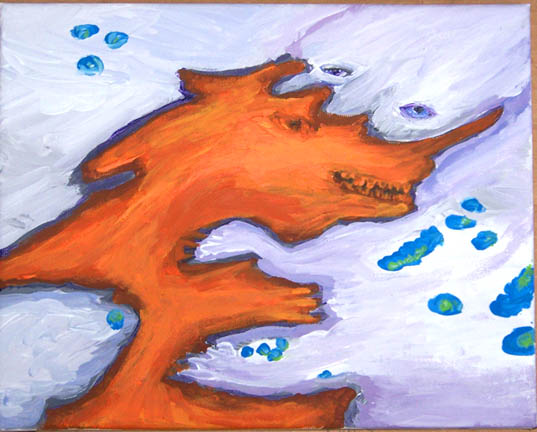
Title: "5,000 YEAR OLD ANNUAL BATTLE
between the Pakistan-Arabia man-made Dust Cloud and the Indonesia-India
summer monsoon moisture trying to move westward to bring rain
to western India, Pakistan, Arabia, the Horn of Africa, across
Africa, across the Atlantic to bring summer rains to the crops
of North America--the Dust Cloud is formed by the domesticated
grazing animals of the region eating the wildlands vegetation
to ground level, creating a massive Dust Bowl-like situation,
where the soil is picked up by the leading edge of the monsoon
winds, and becomes airborne, and the unirrigated dryland farming,
that plows the land instead of using no-till methods, also helps
form the Dust Cloud--the Dust Cloud traps the heat in the air
and also dissipates cloud formation and changes the dew point
so clouds cannot form, so a battle forms every summer--so as long
as the Dust Cloud hovers over a country like Pakistan or Arabia,
drought occurs along with oppressive heat and humidity and at
the same time forms a barrier which can stall the monsoon movement
and cause massive floods in India, Pakistan or Arabia, and it
is the most powerful weather changer on the planet, able to stop
Category 5 cyclones in their track, like GONU, and this image
shows the battle taken by RAMMB or the Regional and Mesoscale
Meteorology Branch of NOAA/NESDIS at Colorado State University
in Fort Collins, Colorado and this was a CIRA Tropical Cyclone
IR Image of the battle as it appeared on June 5, 2013."
Acrylics on canvas, 8" x 10" Painting #48 in catalogue. Copyright image and text © 2013 by Craig Carlton Dremann, all right reserved.
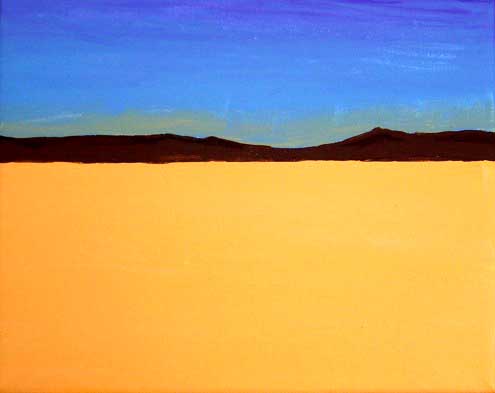
Title: "WATERLESS MARS-LIKE HELL getting started on Earth, where Mars used to have flowing water but now there are only dry river beds on that planet, and now we are creating those conditions on Earth when we allow our domesticated grazing animals to eradicate the native vegetation and this painting is from Jordan at exactly 32 N 38 E which is in the middle of a dry lake bed about 500 feet across and originally the water around 20 feet deep in a lava bed about 50 miles by 50 miles, and within that flow there are about 1,000 dry lakes and dry river beds peppered throughout the area, and if the barren desert to the east was revegetated, then the lakes would refill and the rivers flow again."
Acrylics on canvas, 8" x 10" Painting #49 in catalogue. Copyright image and text © 2012 by Craig Carlton Dremann, all right reserved.
Title: "Craig's Native grass Treasure Map" Series of 24 copies, numbered, dated Oct. 29, 2016 and signed on the back. Dried grass specimens of three natives--Purple Needlegrass, Blue Wild Rye, and Forest Brome on the right. On the left taped in are Wild Oats and Ripgut grass.
Paper file folder, dried grass plants, celophane tape, inkjet labels, black marker pen, 12" x 18", #50 in catalogue. Copyright image and text © 2016 by Craig Carlton Dremann, all right reserved.
Title: "Mysterious signs in the skies above downtown Palo Alto, autumn 2016--the jet contrails are exhaust particles several miles high forming ice cirrus clouds, an interesting cloud-seeding planetary science-experiment, where in the United States alone there are 5,000 planes airborne at any given time, and daily 87,000 planes fly over the USA, and worldwide over 37 million flights per year."
Acrylics on canvas, 8" x 8" Painting
#51 in catalogue. Copyright image and text © 2016 by Craig
Carlton Dremann, all right reserved.
Title: "Cyclone Ashobaa in 2015 on June 11, loosing the battle with the 5,000 year old Pakistan-Arabia Dust Cloud, and when the Dust gripped and stalled the cyclone, and squeezed out the torrential rains that fell in eastern Oman"
Acrylics on canvas, 5" x 7" Painting #52 in catalogue. Copyright image and text © 2016 by Craig Carlton Dremann, all right reserved.
Title:"Cyclone Chapala in 2015 on October 30, the second
most powerful cyclone on record in the Arabian Sea, loosing its
battle with the 5,000 year old Pakistan-Arabia Dust Cloud, current
winner of the "Most Powerful Modifier of the Planet's Weather."
Acrylics on canvas, 5" x 7" Painting
#53 in catalogue. Copyright image and text © 2016 by Craig
Carlton Dremann, all right reserved.
Title: "Cyclone Giri in 2010 on October 26, losing its battle with the Pakistan-Arabia Dust Cloud and being pushed to the NE where it impacted an estimated one million people."
Acrylics on canvas, 5" x 7" Painting #54 in catalogue. Copyright image and text © 2016 by Craig Carlton Dremann, all right reserved.
Title: "Cyclone Gonu in 2007 on June 7, the clearest recent battle between the Pakistan-Arabia Dust Cloud, where the cyclone was trapped and crushed by the bird's mouth of the Dust Cloud in the Gulf of Oman and as it was dissipating over Iran, the first time since 1898."
Acrylics on canvas, 8" x 10" Painting #55 in catalogue. Copyright image and text © 2016 by Craig Carlton Dremann, all right reserved.
Title: "Cyclone Jal in 2010 on November 6, as it was approaching India, lost its strength when it encounters the Pakistan-Arabia Dust Cloud, but was able to invade deep into the heart of the Dust Cloud and brought rains to NW Indian states of Rajasthan and Gujarat."
Acrylics on canvas, 5" x 7" Painting #56 in catalogue. Copyright image and text © 2016 by Craig Carlton Dremann, all right reserved.
Title: "Cyclone Nilam in 2012 on October 31, deadliest cyclone of South India since Jal in 2010, the Dust Cloud splitting the cyclone into two, then disspiating it within the next two days, but the stalling of the storm by the Dust Cloud caused heavy rains and flash floods."
Acrylics on canvas, 6" x 8" Painting #57 in catalogue. Copyright image and text © 2016 by Craig Carlton Dremann, all right reserved.
Title: "Cyclone Nilofar in 2014 on October 28, third-strongest cyclone in the Arabian Sea as a Category-4 on the Saffir-Simpson scale, went toe-to-toe with the Dust Cloud, was kept offshore, unable to make landfall and ended up dying in the middle of the Arabian Sea."
Acrylics on canvas, 5" x 7" Painting #58 in catalogue. Copyright image and text © 2016 by Craig Carlton Dremann, all right reserved.
Title: "Cyclone Sidr in 2007 on November 15, caused one of the worst natural disasters in Bangledesh, when the cyclone hit the eastern edge of the Pakistant-Arabia Dust Cloud, and was pushed along the edge of the Dust Cloud to travel directly over Bangeldesh, causing an estimated $450 million in damages."
Acrylics on canvas, 5" x 7" Painting #59 in catalogue. Copyright image and text © 2016 by Craig Carlton Dremann, all right reserved.
Title: "Cyclone Thane in 2011 on December 28, a Category 2 cyclone getting eaten by the Pakistan-Arabia Dust Cloud as it approaches the eastern coast of India and within three days had been consumed by the Dust Cloud, as you can see the Cloud licking it and getting its first taste on this day."
Acrylics on canvas, 5" x 7" Painting #60 in catalogue. Copyright image and text © 2016 by Craig Carlton Dremann, all right reserved.
Craig Carlton Dremann's
new type of artwork captures
the underlying stories from the natural world, that the landscapes
can tell us. Developed to increase our understanding of human
and natural world interactions. The titles provide a unique vantage
point to interprete the image in an entirely different way.
The titles guide
us to become aware of the details
and histories of the dynamic world we share, and our roles and
responsibilities, and how we can make intentional positive changes
by becoming aware.
Copyright Notice for Liquidated Damages: Lifting text or images from this web page
without a license, you agree to pay on demand, $100 per sentence
per day or $100 per image per day as liquidated damages.
Updated December 20, 2022